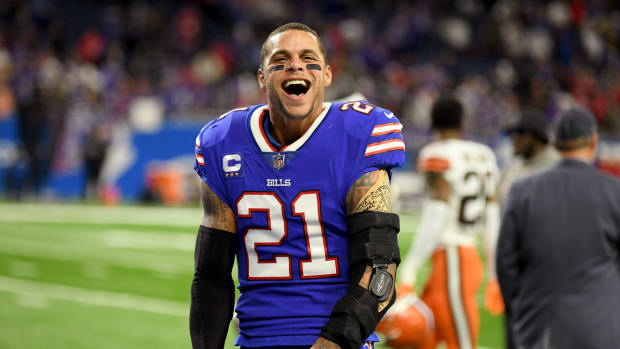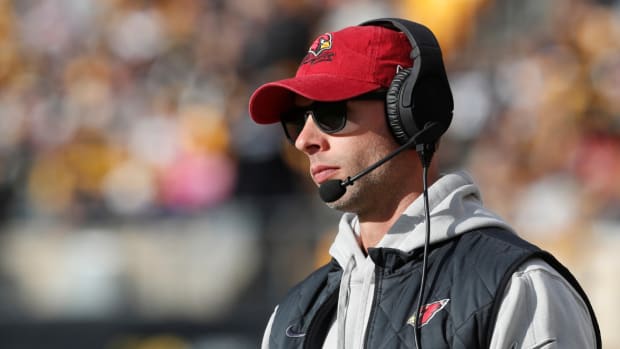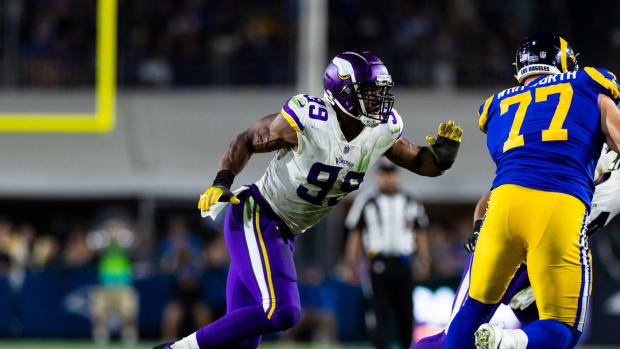How Tom Brady Has Evolved, and What the Eagles Can Do to Beat Him
Tom Brady has reached a level where simply pressuring him is not enough. You must get pressure with only a four-man rush. Your other seven defenders are vital in coverage; blitzing even one of them can leave too many one-on-one matchups and too much downfield space to exploit. Plus, Brady identifies pressure concepts so well before the snap that he’ll often throw before your blitzer can arrive. With seven bodies in coverage, you have a chance to at least make Brady hold the ball. It’s no coincidence that his only two Super Bowl losses have come against the two best four-man rushes he’s faced: the 2007 Giants and ’11 Giants.
Remarkably, Brady, at 40, has played better not just mentally but physically than he did in those ’07 and ’11 seasons. (More on that momentarily.) Brady’s football IQ now tops most coaches’, allowing New England to run the league’s most expansive offensive scheme.
Recently, that expansiveness has led the Patriots to more downfield passes. Midway through last season, those downfield throws started replacing some of the underneath quick-strikes that were built around Julian Edelman. When Edelman tore his ACL in the preseason, this became a full-fledged vertical offense. That’s simply an adaptation to the remaining personnel. Wide receiver Brandin Cooks is one of the game’s speediest deep threats, plus his throttle-down ability is second only to Antonio Brown. This makes Cooks lethal on deep curl routes and comebackers. (He destroyed Jaguars Pro Bowl corner A.J. Bouye with these in the AFC championship.) Accompanying Cooks is Chris Hogan, an understated vertical weapon who can burn an unsuspecting defense outside or from the slot. And, of course, there’s Rob Gronkowski, maybe the best vertical inside weapon to ever play tight end.
Downfield passes tend to come out of running formations, where play-action factors in and defenses are more predictable. The Patriots don’t have a GREAT ground game, but it’s steady enough to keep them balanced and on-schedule. What has defined this offense in 2017, however, is the same thing that defined Philly’s under Carson Wentz (and, in the NFC championship game, under Nick Foles): Its quarterback’s rare ability to extend plays from within the pocket and make difficult throws late in the down.
When you extend plays within the pocket, as opposed to breaking down and moving outside, you expand the entire play’s design past the point that any coverage can handle. All of your eligible receivers remain options, not just the ones to the side where you escaped. True to what we’ve come to expect from a Bill Belichick-coached team, the 2017 Patriots are not dependent on their new predominant style of play. In fact, they beat the Titans in the divisional round by returning to the Edelman-styled spread formations, creating mismatches inside and moving the ball in five- to eight-yard increments. (Danny Amendola plays the Edelman role.) That pristine dink-and-dunk passing game, which also contributed to New England’s fourth-quarter comeback over Jacksonville, is what Eagles defensive coordinator Jim Schwartz will focus most on stopping. That’s because Schwartz must operate under the assumption that his defensive line, which has been the NFL’s best all season, can disrupt Brady on its own. If it doesn’t, Philly’s chances shrink significantly, as Schwartz will have to reach into the bag of blitzes that he used rarely in ’17 (though, granted, with surprising frequency in the NFC title game).
Stud utility defender Malcolm Jenkins prospered in many of those blitzes, but it’s hard to envision him rushing Brady in Super Bowl LII given that he’s the defender best equipped to battle Gronkowski. It wouldn’t be a pure one-on-one battle; the Eagles play a lot more zone than man-to-man. Guarding Gronk and Amendola inside will be a collective effort. The only straight one-on-one matchups will occur on the perimeter, with Ronald Darby at right corner and Jalen Mills at left corner. The Patriots will align Cooks opposite whichever corner they feel he best matches up to, and you can bet Cooks will execute one or two of the double-moves that Darby and Mills struggled against in December.
The tendency is to think that you must change things up against Brady; some defensive coaches believe he is truly unstoppable if he knows what coverage you’ll employ. But not Schwartz. Instead of trying to play smarter than history’s best field general, Schwartz will try to play faster. That means a lot of straightforward but aggressive zone concepts. This is the best chance at making Brady hold the ball and contend with the four-man rush that got Philly here.
As recently as two years ago, Brady holding the ball against a dominant pass rush would present optimism for Patriots opponents. But with how well Brady has navigated messy pockets and thrown from under duress this season, it’s likelier that the GOAT’s sixth Super Bowl title will simply be achieved in even more spectacular fashion than the first five.
Prediction: Patriots 27, Eagles 16
• Question or comment? Email us at talkback@themmqb.com.




































